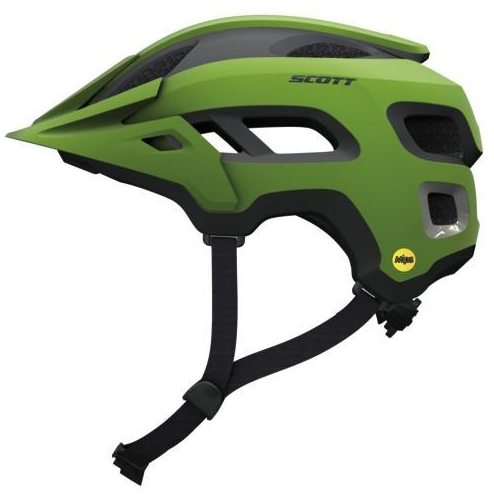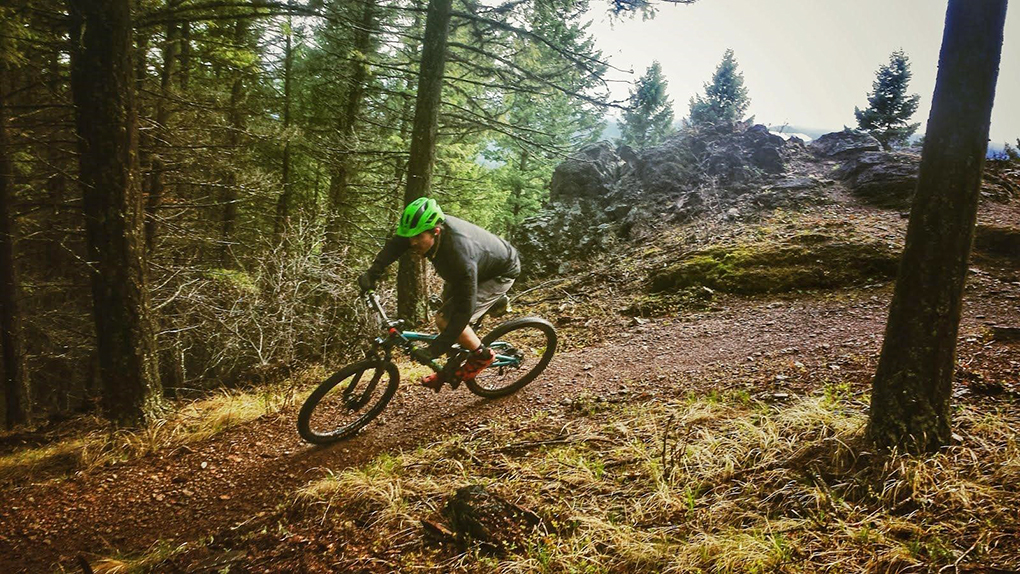
Scott Stego Helmet
Size Tesed: Medium; 55-59cm
Manufacturer’s Stated Weight:
390 grams (size Medium)
Blister’s Measured Weight: 407 grams
Color: Metallic Green/Black
MSRP: $160
Reviewer Info: 6’1” 190 lbs, 57cm head
Duration of Test: 3 Months
Locations: Whitefish, MT, and the Pacific Northwest (North Shore of Vancouver & Sunshine Coast, BC)
With the Stego helmet, Scott Sports joins a growing contingent of manufacturers offering an all-mountain helmet that provides more complete coverage than a standard cross country lid.
Other Blister reviewers have tested a number of helmets in this emerging category, including the Smith Forefront, Bern Morrison, and the POC Trabec. So the question is whether the Stego brings something special to the table? Why choose it over these other “full-coverage” all-mountain options? This review of the Stego’s features and performance should help you arrive at an answer.
Fit & Sizing
Scott says the Stego’s Micro Rotary Adjustment System II (the sizing adjustment knob at the back of the helmet) provides “unparalleled comfort, adjustment and stability.” Smith has built its new Forefront with a very similar, effective adjustment system, so while Scott’s MRAS II doesn’t seem “unparalleled,” it does provide a comfortable, secure fit. The ratchet system is very easy to operate on the fly with one hand, and is more convenient than adjustment / closure systems that require grabbing two tabs at the back of the helmet with two hands (like that on the POC Trabec).
The Stego’s sizing seems accurate. In the past, with similar Giro, Bell, and Poc helmets, I’ve been stuck in No Man’s Land, in between a size Medium and a Large. With the Stego, a size Medium, which is said to fit heads that are 55-59cm in circumference, has fit my 57 cm head very well. I also have a fairly round head, so if you’ve had issues with helmets feeling like their shape is too oblong, the Stego could be a good choice.
The straps on the Stego work well. I did notice that the frames of my sunglass fit much better resting inside the straps rather than outside of them. This did make it slightly troublesome to take glasses on/off, but it’s a very minor complaint, and you may not notice this with another pair of glasses.

Features
The Scott Stego has a set of features that can be divided into two categories: compatibility and protection. We’ll start with compatibility.
The middle section at the top of the helmet has a mostly flat, smooth surface, perfect for placing a GoPro camera mount. The Stego also has as a removable visor which makes the donning of goggles a bit easier.
Riding with the visor on, I was pleased that my sunglasses fit well with the helmet and could be stowed securely upside down, facing forward above the visor. My only complaint with the Stego’s visor is that it’s angle isn’t adjustable, and at times, it limited my vision down the trail on steep descents.
Protection
The Stego has two main features that set it apart from a standard cross country lid. The most obvious safety feature is the extended coverage the helmet provides compared to a traditional cross country lid. Like other all-mountain helmets (e.g., the Smith Forefront, Bern Morrison, and POC Trabec), the Stego’s material extends down lower on the side of the head, in front of and behind the ear, as well as at the back of the head, toward the neck. As today’s 5 and 6 inch trail bikes can easily be pushed to “holy sh*t” kinds of speeds, I really appreciate the increased level of coverage the Stego provides.
Scott has also licensed MIPS technology from Swedish company MIPS AB for use in the Stego’s design. MIPS (Multi-directional Impact Protection System) basically treats the main body of the helmet and the inside padding that your head rests against as two separate units. More precisely, the helmet’s inside padding is attached to a very thin plastic sub frame, which is held to the main body of the helmet itself by four flexible rubber connection points.
Because the parts of the helmet that touch your head can rotate independently from the rest of the helmet, MIPS says the rotational acceleration of the brain during an oblique impact is significantly reduced. In more conventional terms, this means that if your head strikes something at an angle (which is very likely to occur—we don’t often fall directly on the tops of our heads) your head won’t get jerked to the side or rotated quite as violently as it would in a conventional helmet.
I didn’t experience an “oblique angle impact” with this helmet during testing (thankfully), but the test results on MIPS website certainly suggest the technology is more than a marketing gimmick. The MIPS system seems like a simple yet very clever way to minimize trauma during an angled impact, which the conventional designs of most other helmets on the market don’t aim to address.
Venting
Most of my time spent testing the Stego was either in the Pacific Northwest or Montana, where temperatures are rarely uncomfortably warm. Still, nothing would lead me to think the Stego’s 17 large vents couldn’t supply plenty of airflow to keep your head cool in warm riding conditions.
I haven’t tested them myself, but for what it’s worth, Jeremy Benson and Noah Bodman didn’t have any complaints about the venting of the Smith Forefront or POC Trabec, either. (The Stego has one more vent that the Trabec, and other than that, the Stego’s venting seems very similar). On the other hand, in his review of the Bern Morrison, Tom Collier had a few complaints about the Morrison getting hot even when temperatures were around 55 degrees F.
Weight
The Stego I tested came with a specs label that listed the helmet’s weight at 390 grams, and our measured weight was 407 grams.
(Note: this 390g weight was listed on the inside the helmet along with its sizing info and safety certifications. However, Scott’s website says the Stego weighs in at 340 grams. We’ve asked Scott to confirm the official, stated weight for the helmet, but I’m confident in the measured weight of the size Medium Stego I’ve tested.)
For reference, Smith’s new Forefront helmet (the lightest all-mountain helmet we’ve tested) comes in at a svelte 327 grams. But while the weight difference between the Forefront and the Stego is noticeable when holding both helmets, it’s hard to tell the difference when they’re on your head. And ultimately, I didn’t find the Stego’s weight to be an issue at all.
